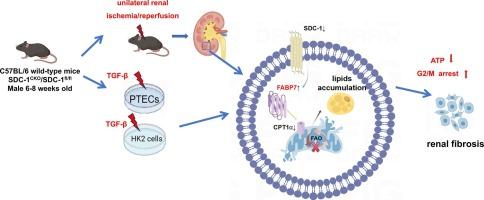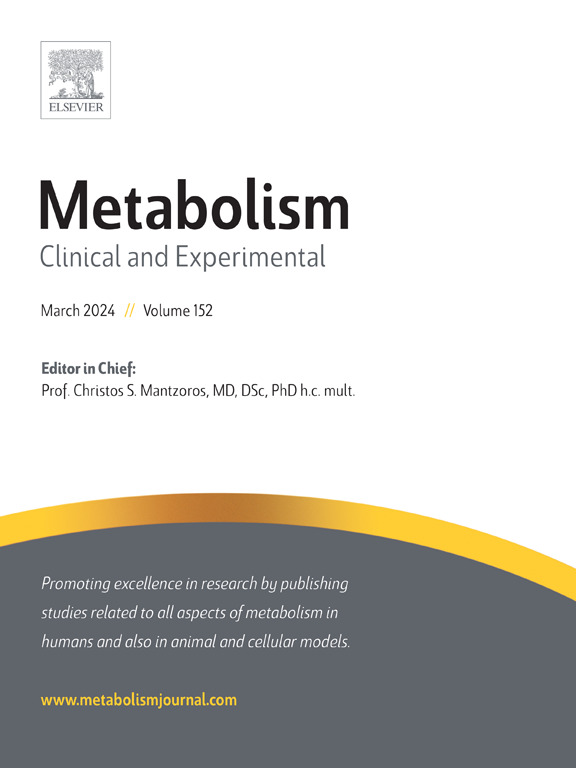Syndecan-1调节脂质代谢,减轻急性肾损伤向慢性肾病转变过程中的纤维化。
IF 11.9
1区 医学
Q1 ENDOCRINOLOGY & METABOLISM
引用次数: 0
摘要
背景:从急性肾损伤(AKI)到慢性肾脏疾病(CKD)的转变以持续的肾纤维化为特征,其中异常的脂质代谢起着至关重要的作用。Syndecan-1 (SDC-1)参与多种组织重塑过程;然而,在从AKI到CKD的过程中,其在脂质代谢和纤维化中的作用尚不清楚。方法:本研究采用小鼠单侧缺血再灌注诱导的aki向ckd进展模型进行体内分析,并采用转化生长因子β (TGF-β)诱导的人肾-2细胞和小鼠原代小管上皮细胞纤维化进行体外研究。利用小管特异性敲除和SDC-1小鼠的过表达来研究肾脏纤维化和脂质代谢。结果:单侧缺血再灌注和TGF-β刺激后,SDC-1表达明显降低,加重肾纤维化。值得注意的是,SDC-1缺乏导致肾脏脂质积累,而其过表达减轻了脂质过载并改善了代谢参数。此外,SDC-1在调节脂肪酸结合蛋白7 (FABP7)中起着至关重要的作用,其缺失导致FABP7水平升高。抑制FABP7不仅可以减少纤维化,还可以恢复肉碱棕榈酰基转移酶1α的表达,这表明SDC-1/FABP7轴对维持肾脏脂质稳态和减轻纤维化至关重要。结论:这些发现强调了SDC-1在脂质代谢中的重要性,并提示靶向脂质代谢途径可能是减缓AKI向CKD进展的治疗策略。本文章由计算机程序翻译,如有差异,请以英文原文为准。

Syndecan-1 regulates lipid metabolism and mitigates fibrosis during the transition from acute kidney injury to chronic kidney disease
Background
The transition from acute kidney injury (AKI) to chronic kidney disease (CKD) is characterized by persistent renal fibrosis, in which abnormal lipid metabolism plays a crucial role. Syndecan-1 (SDC-1) has been implicated in various tissue remodeling processes; however, its role in lipid metabolism and fibrosis during the progression from AKI to CKD is not well understood.
Methods
This study used a murine model of unilateral ischemia-reperfusion-induced AKI-to-CKD progression for in vivo analysis and employed transforming growth factor-beta (TGF-β)-induced fibrosis in Human Kidney-2 cells and primary mouse tubular epithelial cells for in vitro studies. The tubule-specific knockout and overexpression of SDC-1 mice were utilized to investigate kidney fibrosis and lipid metabolism.
Results
Following unilateral ischemia-reperfusion and TGF-β stimulation, SDC-1 expression was significantly reduced, exacerbating renal fibrosis. Notably, SDC-1 deficiency led to lipid accumulation in the kidneys, while its overexpression alleviated lipid overload and improved metabolic parameters. Furthermore, SDC-1 played a crucial role in regulating fatty acid-binding protein 7 (FABP7), and its absence resulted in increased FABP7 levels. Inhibition of FABP7 not only reduced fibrosis but also restored carnitine palmitoyltransferase 1α expression, which suggests that the SDC-1/FABP7 axis is critical for maintaining lipid homeostasis and mitigating fibrosis in the kidney.
Conclusion
These findings underscore the importance of SDC-1 in lipid metabolism and suggest that targeting lipid metabolic pathways may represent therapeutic strategies that can slow the progression of AKI to CKD.
求助全文
通过发布文献求助,成功后即可免费获取论文全文。
去求助
来源期刊

Metabolism: clinical and experimental
医学-内分泌学与代谢
CiteScore
18.90
自引率
3.10%
发文量
310
审稿时长
16 days
期刊介绍:
Metabolism upholds research excellence by disseminating high-quality original research, reviews, editorials, and commentaries covering all facets of human metabolism.
Consideration for publication in Metabolism extends to studies in humans, animal, and cellular models, with a particular emphasis on work demonstrating strong translational potential.
The journal addresses a range of topics, including:
- Energy Expenditure and Obesity
- Metabolic Syndrome, Prediabetes, and Diabetes
- Nutrition, Exercise, and the Environment
- Genetics and Genomics, Proteomics, and Metabolomics
- Carbohydrate, Lipid, and Protein Metabolism
- Endocrinology and Hypertension
- Mineral and Bone Metabolism
- Cardiovascular Diseases and Malignancies
- Inflammation in metabolism and immunometabolism
 求助内容:
求助内容: 应助结果提醒方式:
应助结果提醒方式:


